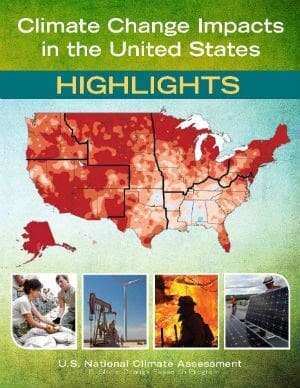Today, the Obama Administration unveiled the Third U.S. National Climate Assessment. This report confirms that climate change is affecting Americans in every region of the U.S. and key sectors of the national economy.
Certain types of extreme weather events with links to climate change have become more frequent and/or intense, including prolonged periods of heat, heavy downpours, and in some regions, floods and droughts. In addition, warming is causing sea level to rise and glaciers and Arctic sea ice to melt, and oceans are becoming more acidic as they absorb carbon dioxide. These and other aspects of climate change are disrupting people’s lives and damaging some sectors of our economy.
These findings underscore the need for urgent action to combat the threats from climate change, protect American citizens and communities today, and build a healthy, sustainable future for our children and grandchildren.
The report, a key deliverable of President Obama’s Climate Action Plan, is the most comprehensive and authoritative scientific report ever generated about climate changes that are happening now in the U.S. and further changes that we can expect to see throughout this century.
It communicates the impacts of climate change according to geographic region of the U.S., and by economic and societal sector-including agriculture, energy, and health. These tailored findings help translate scientific insights into practical, usable knowledge that can help decision-makers and citizens anticipate and prepare for specific climate-change impacts.
The assessment is the result of a three-year analytical effort by a team of over 300 climate scientists and experts, informed by inputs gathered through more than 70 technical workshops and stakeholder listening sessions held across the country. The resulting product was subjected to extensive review by the public and by scientific experts in and out of government. This process of unprecedented rigor and transparency was undertaken to ensure that the findings of this report rest on the firmest possible base of expert judgment.



In viewing both the precipitation change map and the temperature change map, it appears that there is a high correlation between those areas that were massively deforested during the 20th Century.
Certainly it is easy to draw a parallel to the African continent on which bountiful forests once providing a supportive environment to the indigenous tribes, In much of the African continent, the trees in these vibrant forests were cut to obtain firewood. In those same areas, arid deserts now exist.
Further supporting this thesis, in the Jared Diamond epic “How Societies Choose to Fail or Succeed”, one key critical difference of societies that survived preserved their forests. The key example given was Japan, where the Emperor decreed that no tree would be cut down.
Given that Diamond is one of the few awarded both Pulitzer and MacArthur status, as well as inclusion in Time Magazine’s 25 most influential American list, his credibility is beyond reproach.
If this theory proves to be valid, it makes sense to study abatement of our overwhelming carbon dioxide concentration in the atmosphere by developing a plan to plant massive numbers of trees in areas in which their adaption is certain.
It is a scientific fact that trees absorb carbon dioxide and emit oxygen. The feasibility of massive scaling up of reforestation should be studied and implemented by forestry professionals.